
The annual Recycling Progress Report (PDF) provides an update on implementation of Hennepin County’s Solid Waste Management Master Plan, progress toward waste diversion goals, and a summary of the 2020 results for the county’s waste management programs.
Amount of waste generated and recycling rate
About 1.24 million tons of solid waste, which includes recycling, organics, and trash, was generated in Hennepin County in 2020. That is a 1% decrease from 2019, or about 7,000 tons less. Of the total tons generated, 42% was managed as recycling and organics. The remaining 58% was managed as trash at a waste-to-energy facility or landfill.
|
The impact of COVID-19 and changes to waste reporting contributed to shifts in waste management data in 2020 compared to previous years. For example, as offices, businesses, and schools shut down in spring 2020 and people spent more time at home, the amount of waste generated shifted from the commercial sector to residential.
2020 results and future strategies
The report highlights the county’s results and strategies going forward in the following areas:

Continuing important services during a challenging time
Throughout the challenges and disruptions of 2020, the county continued to provide disposal services and conduct inspections, pivoted to virtual offerings, adjusted to meet the needs of the community, and made progress on many priority initiatives.
Connecting zero waste and climate action
|
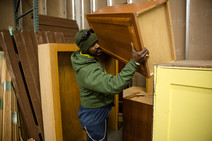
Strategies to reduce waste and increase the sustainability of materials are important components of achieving the county’s goal of net zero greenhouse gas emissions by 2050. The county’s Climate Action Plan includes strategies to prevent food waste, divert organic materials from the trash, reuse and recycle construction and demolition waste, understand and mitigate the climate impacts of our purchases, and advocate for state leadership on zero waste policies and producer responsibility.
|

Achieving more through collaboration
Through the Partnership on Waste and Energy (PWE), a Joint Powers Agreement between the Ramsey/Washington Recycling & Energy Board and Hennepin County, the county made progress on anaerobic digestion development, online training for hazardous waste generators, and a consumer education campaign on battery disposal. The county also provided statewide leadership on product stewardship.
|
Focusing on organics

Organic materials are the largest proportion of our trash – making up about 25% of the trash stream. Diverting organic materials, which include food, food-soiled paper, and compostable products, is the biggest opportunity to reduce our trash. This involves many different strategies, including food waste prevention, food rescue for hunger relief, food-to-animals, composting, and anaerobic digestion.
Making progress on master plan strategies
|
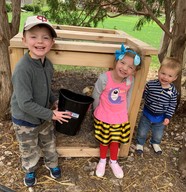
Many of the county’s programs adapted to health and safety guidelines in order to continue to provide services and engage residents. The report highlights results in recycling organics, preventing waste, conducting education and outreach, serving residents at home, work, school, and on-the-go, promoting drop-offs for hazardous waste and additional recyclables, and recovering resources from the trash.
For more information, contact Ben Knudson at ben.knudson@hennepin.us or 612-596-1176.
|
Hennepin County is working to protect the last, best remaining natural areas in the county and conduct habitat restoration projects on protected properties.
The natural areas and diverse landscapes in Hennepin County provide critical habitat for wildlife, protect water quality, offer recreational opportunities, and serve as the foundation for the region’s environmental wellbeing, economic prosperity, and collective quality of life. Protecting and enhancing natural areas will make the county more resilient to climate change.
The following projects are some of the county’s recent work to protect and restore natural areas.
Expanding the Wood-Rill Scientific and Natural Area in Wayzata
 Spiny water fleas on fishing line. Credit: J. Gunderson
The county board recently approved the acquisition of two parcels by the Minnesota Department of Natural Resources to expand the Wood-Rill Scientific and Natural Area (SNA) in Orono. The addition of these two parcels will create a 178-acre area of habitat and help establish a corridor of protected habitat that connects Wood-Rill SNA to the Wolsfeld Woods SNA and Baker Park Reserve.
SNAs protect the best of Minnesota’s remaining natural heritage, including rare species, native prairies, old-growth forests, and significant landforms and geologic features. The Wood-Rill SNA includes high-quality sugar maple forest, tamarack swamp, sedge meadows, and wetland areas. The Wood-Rill SNA is open to the public for hiking and is a popular birding location.
Restoring habitat at the Cullen Nature Preserve in Minnetonka
A group of volunteers that make up the Friends of the Cullen Nature Preserve are working to restore the natural habitat of the property in Minnetonka. This work will fulfill Ann Cullen Smith’s vision of protecting the 32-acre property, which she placed into a conservation easement to ensure its permanent protection.
The group received a natural resources grant from Hennepin County and funding from the Minnesota Department of Natural Resources to restore the property by removing buckthorn, using prescribed burns to control vegetation, and replanting to improve biodiversity and habitat. The restoration project is expected to take three years, and the nature preserve is likely to open to the public in 2025. Read more in the Sun Sailor.
Improving soil health at the Minnesota River Valley prairie restoration in Eden Prairie
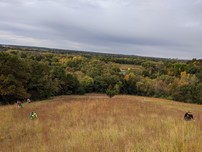
Hennepin County has been working closely with the Metropolitan Airports Commission and U.S. Fish and Wildlife Service to restore and enhance some of the last remaining native prairie adjacent to the Minnesota Valley National Wildlife Refuge. County staff recently planted cover crop with a goal of improving soil health. Over the next two years, the county will be doing soil testing to see if the cover crop results in changes to nutrients and carbon. The area will be reseeded with prairie seeds that have been collected from nearby prairies next fall.
|
|
Have you done a home project using reused materials? Whether you've made a coffee table from reclaimed wood or remodeled a bathroom with antique fixtures, let your ingenuity inspire others! We’re looking for projects to feature in an upcoming article on Choose to Reuse.
Share your story and photos by June 15 to jointhecircle@hennepin.us. Our three favorite projects will be featured in a special blog post.
|
|
 |

Each spring, free compost is available to Hennepin County schools with organics recycling programs. The finished compost is meant to help “close the loop” on organics recycling.
The food and other compostable waste collected by schools from their cafeterias is delivered to commercial composting facilities, where it is mixed with yard waste and turned into nutrient-rich compost. The compost schools receive in the spring can go back into gardens to improve the soil.
In late April and early May, the county partnered with The Mulch Store, one of the compost sites where school organics recycling is delivered, to offer the free compost. Compost was delivered to 34 schools where it was used by students, facilities staff, garden managers, and parent volunteers to add nutrients to the soil in areas like vegetable gardens, flower beds, and around trees.
For more information, contact Kira Berglund at kira.berglund@hennepin.us.
|
A new movement is underway to stop the spread of spiny water fleas. There is no control method for these microscopic critters once they are in a lake, so preventative action is critical to controlling spread. Although spiny water fleas are very small and clear, their black eye spot makes them more visible to the naked eye (see photo), especially when clustered on fishing line.
 Spiny waterfleas on fishing line. Credit: J. Gunderson

Researchers have discovered that a dish cloth known as a Swedish dish cloth does the best job at removing spiny water fleas from fishing lines and equipment. If you are visiting an infested lake, purchase one of these cloths at a kitchen store, gift shop or online and wipe down your fishing line and reels. Also be sure to drain and wipe down live wells and bait buckets.
Spiny water flea infestations are currently found in northern and northeast Minnesota lakes. See what lakes are infested and learn more about spiny water fleas.
|

Hennepin County has healthy tree canopy grants available for tree plantings, ash tree removals, tree inventories, outreach and more. Grants are available to cities, affordable housing properties, schools, and nonprofit organizations.
Applications are due by 3 p.m. on Thursday, June 10. Learn more and apply.
For more information, feedback on your project ideas, or help with your application, contact the Hennepin County forestry team at trees@hennepin.us.
|
Learn tips and tricks for stopping food waste at an upcoming webinar
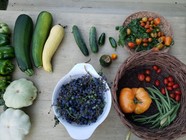
Learn how to save money, set a good example, and have a positive impact on the planet by attending a food waste prevention webinar! The webinar will provide tips and tricks for making the most of your food through shopping, storage, and cooking.
Schedule
Webinars for Hennepin County residents who live in apartments and condos are scheduled for:
- Monday, May 7 at 7 p.m.
- Thursday, June 10 at noon
Webinars for all residents of Hennepin County are scheduled for:
- Wednesday, June 23 at 7 p.m.
- Friday, June 25 at noon
Sign up to attend
The webinars will be hosted by Hennepin County GreenCorps member, Marielle Mateo. The webinars will be about one hour with time for questions. They are offered free of charge, but registration is required.
If you have any questions, email marielle.mateo@hennepin.us.
|
Household hazardous waste collection event in Minneapolis and St. Louis Park
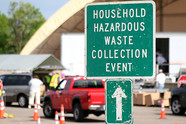
Hennepin County holds community collection events for county residents to safely and properly dispose of unwanted garden and household hazardous wastes. Events are held Fridays and Saturdays from 9 a.m. to 4 p.m.
Events in June are being held:
- June 11 and 12 at the St. Louis Park Middle School
- June 25 and 26 at Pillsbury Elementary School in northeast Minneapolis
Find health and safety guidelines and a list of acceptable materials at hennepin.us/collectionevents.
|
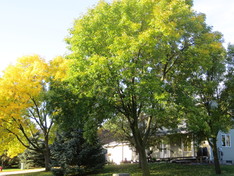
The trees around us provide many benefits. They improve air and water, make our communities healthier, create wildlife habitat provide shade, save energy, and increase property values. The older the tree, the more benefits it provides.
Emerald ash borer, an invasive tree pest that attacks and kills ash trees, are the biggest current threat to our trees. There are over 1 million ash trees in Hennepin County, and all of them are threatened by the emerald ash borer.
Treatment is an option to preserve high-value ash trees
A healthy, mature ash tree may be worth saving, and treatment with an insecticide is an option to preserve ash trees of high value.
Watch our new video, protect ash trees from the threat of emerald ash borer (YouTube), to learn how to determine if your tree is worth saving and see how treatment works.
|

Deciding if your tree is worth saving
To decide if your tree is worth saving:
Learn more about ash trees and emerald ash borer at hennepin.us/ashtrees.
|